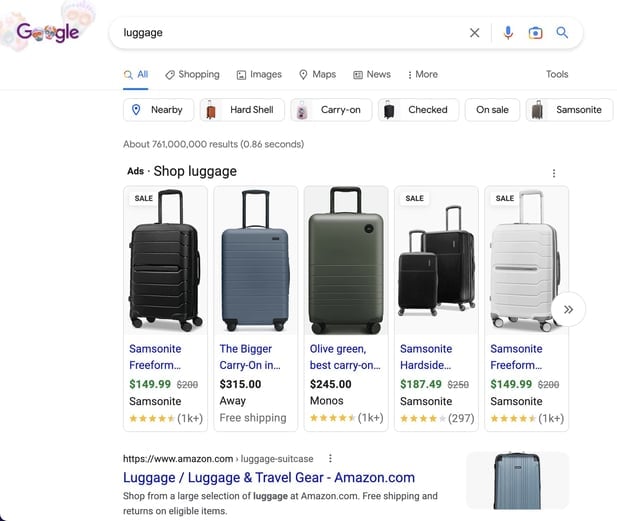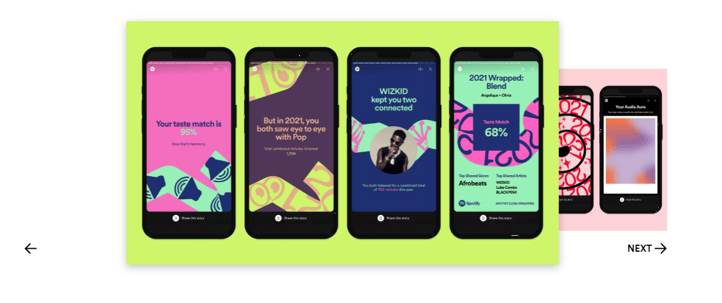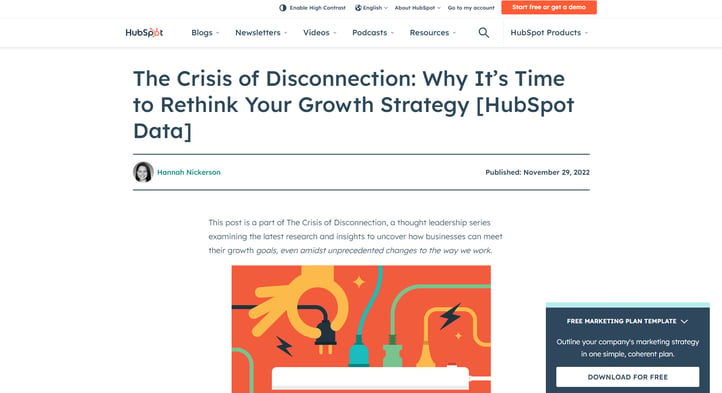Are you struggling to get started with digital marketing? Do you feel overwhelmed by all the information available online?
Don't worry. This guide will teach you everything you need to know about digital marketing. It's the ultimate guide to digital marketing because it covers every aspect of digital marketing including SEO, social media, email marketing, content creation, paid advertising, analytics, conversion optimization, etc.
Digital marketing is on the rise, with about 64% of the world's population on the Internet. According to new figures from Data Reportal, the number of people using the internet has grown by more than 170 million in the 12 months as of October 2022.
We'll walk you through the basics of digital marketing and explain why it's important to understand these concepts before jumping into any new projects. Then we'll go over the digital marketing examples that will shape the future of marketing. Finally, I'll cover the most popular social media platforms and tell you where to focus your efforts.
|
Digital Marketing Digital marketing is advertising delivered through digital channels to help promote brands and connect with potential consumers. |
What is Digital Marketing?
Digital marketing is a broad term used to describe all types of marketing campaigns that take place over the Internet. These include everything from advertising to customer service.
Inbound marketing is a subset of digital marketing where businesses use content marketing to attract potential clients. Inbound marketing focuses on attracting visitors rather than selling products.
The main difference between inbound and outbound marketing is that inbound marketing is focused on providing useful information to people looking for solutions. Outbound marketing, on the other hand, sells things directly to consumers.
How does a business define digital marketing?
At this point, digital marketing is essential for your business and brand recognition. Every other company has a website, and if they don’t, they at least have some kind of social media presence or digital marketing strategy. Digital content and marketing have become so commonplace that people now look for and rely on them as an easy way to learn about brands and products. As there are so many different ways to market online, you can be creative and experiment with various marketing tactics without breaking the bank.
Online marketing is the use of various digital tactics and channels to reach out to potential clients where they spend most of their time: online The best digital marketers have a clear understanding of how every digital marketing strategy helps them achieve their overall business goals. Depending on the goals of their marketing strategy, marketers can support a larger campaign through the organic and paid channels at their disposal.
For instance, a content marketer could write a series of blog posts that generates leads from an e-book. Social marketing campaigns may include paid and organic posts on a business's social networking pages, and email marketing campaigns may be used to send people who download the eBook more info on the company. Let's talk more about these specific types of digital marketers later.
B2B versus B2C digital marketing
Digital marketing strategies work for both B2B (businesses to businesses) and B2C (businesses to consumers) companies, but best practice differs significantly between the two. Let’s take a closer peek at how digital marketing is utilized in B2B and B2C marketing strategies:
- B2B companies tend to have longer decision-making processes than B2C companies. Therefore, relationship-based marketing strategies are best suited for B2B companies. On the other hand, B2C companies usually respond well to shorter-term offers and messages. Thus B2B process has a longer sales funnel than B2C.
- B2B sales are usually driven by logic and evidence, whereas B2C sales are more emotional, focusing on making the buyer happy about buying from you.
- B2B customers often require multiple people's inputs before making a decision. The types of content that best drive these B2B purchases are usually shareable and downloadable. However, B2C customers prefer one-on-one interactions with brands.
- There are always exceptions to every generalization. For example, a B2C company with an expensive product, such as a luxury item, may provide more informative and serious material than a B2B company with a low-cost product, such as a software application.
- Look at your current audiences to develop well-targeted online marketing campaigns. Doing this ensures your marketing efforts are successful and you're able to attract potential buyers.
Why is digital marketing important?
Digital marketing is becoming increasingly important because of how easy it is to access. According to Statista, there are over 5 billion people online around the world today, and that number is expected to grow to 6 billion by 2027. This means there are plenty of potential customers out there to reach. Digital marketing allows you to connect with those customers, whether they’re located near or far away.
Additionally, digital marketing has minimal upfront costs, making it a great option for small businesses. You don’t need to spend thousands of dollars to start implementing digital marketing strategies into your business. Instead, you can implement free tools like Facebook ads, Twitter campaigns, and email marketing. These types of marketing tactics allow you to test different approaches without spending too much money.
The benefits of digital marketing
1. Targeting Your Audience
Digital marketing allows you to gather consumer data in a way that traditional methods cannot. With digital marketing, you can collect information about customers' interests, behaviors, demographics, and even what they're looking at online. This type of data helps companies understand their target audience better and develop personalized messages and experiences.
Data gathered digitally tends to be much less vague and broad than data collected via offline channels. For example, it's easier to find out whether someone lives near a certain location or how old they are based on their IP address than it is to determine those things by asking them directly.
Imagine you offer financial services and you want to send out special deals to internet users who have looked at your retirement plan. You know you'll get more targeted responses if you tailor the deal to the individual's interest, so you prepare two campaigns. One is for young families and the other is for millennials.
2. Reaching Customers
With digital marketing, you can reach customers all over the world. Traditional media outlets were limited to local markets, but now you can advertise worldwide. If someone searches for a certain product in Australia, you can show them advertisements for that same product in Canada.
3. Cost efficiency
Digital marketing not only has a larger reach than traditional marketing but also requires less overhead. You don't have to pay for printing, distribution, and other expenses associated with traditional advertising methods. And because digital media allows you to specifically direct your message to specific people at any time, you get better results than if you were using traditional media.
You can use digital marketing to attract people to your blog by creating just one piece of content, as long as your blog is active. You can set up an emailing campaign that sends messages to specific target audiences at specified times, and it's easy enough to change the frequency or send different types of emails to different groups.
When you add it up, digital marketing gives your business much more flexibility and customer interaction for your advertising budget.
4. Brand Awareness
With digital marketing, you can create brand awareness. When you market your products through social media, you can let your customers know about new releases, special offers, and other information. You can also keep your current customers informed about your company's activities. For example, you could post pictures from your latest event or share videos of your employees working hard.
5. Adaptable
Marketing strategies can be difficult to develop. They generally involve following through with a set of actions until completion, allowing them to come to fruition, and then evaluating their success.
However, things rarely run smoothly. Sometimes, you may find yourself realizing halfway through that a formula was wrong, an assumption was inaccurate, or your audience didn't respond as anticipated. Pivoting or adjusting your marketing campaign along the way is extremely helpful because it allows you to avoid starting over entirely.
Changing a digital marketing strategy is easy because adopting a digital marketing strategy is much easier than changing a print or TV campaign. For example, if an online ad doesn't deliver as expected, you can easily adapt it or pause it to get better results.
6. Digital marketing is measurable
Traditional advertising can be helpful for certain goals, such as increasing awareness about a product or brand. But its biggest limitation is measurability. With digital marketing, however, you can track everything from the number of times someone visits your site to whether he or she clicked on a link. You can even use data analytics tools to determine what type of person visited your site, where they came from, and what keywords they used while there.
This level of insight gives you a complete picture of how well your online ads are performing. And because you're able to measure every single metric associated with your campaigns, you can make adjustments accordingly. For example, if you notice that some customers aren't converting into purchases, you can adjust your copy or design to improve conversions.
7. Improves your conversion rate and quality of your leads
With digital marketing making it easier to measure your marketing activities, this makes improving your conversions easier too. Measuring the effectiveness of each strategy allows you to develop better ones. Refining your methods continuously improves your conversion rates. Online marketing helps ensure that everything is optimized for maximum conversion rates.
All leads don't offer the same level of benefit for your business. Digital marketing lets you target a specific audience that yields better quality prospects who are more likely to turn into sales. Connecting your online presence to the most valuable leads will help boost your overall conversion rates.
Types of Digital Marketing
Here's an overview of some of the different types of digital marketing:
1. Search engine optimization
Search Engine Optimization (SEO) is the process by which you optimize your website so that it ranks better in search engines, thereby increasing the amount of organic (free) traffic your website receives through Google, Bing, Yahoo!, etc.
An important part of digital marketing is making sure your website ranks high enough in Google searches so that people who type relevant keywords into Google see your website when they click on one of the top links. These channels that can be optimized for SEO include websites, blogs, and infographics.
There are several different approaches to SEO to generate quality website visitors. Some of these include:
On-page SEO
This type of SEO looks at all of the content that's already there when people visit a website. Researching keywords' search volumes and intents helps you write better content that answers reader queries and ranks higher on search engine results pages(SERPs).
Off-page SEO
This type of SEO concentrates on all of the activities that take place off the page when trying to improve your rankings. "What actions outside of my control can impact my rankings?" You may wonder. The answer is inbound links, also called backlinks. The quantity and quality of these links directly correlate to your site's position in Google. By building relationships with other sites, sharing relevant information, and earning them links to your site, you can increase the amount of traffic flowing through to your pages.
Technical SEO
Technical SEO focuses on the back end of your site, and how your web page content is coded. For example, image compression, structured data, CSS file optimizations, etc., are all forms of technical SEO that can improve your site's load time — which is one of the most important factors for a good user experience.
2. Content Marketing
Content marketing refers to the creation and distribution of content (e.g., blogs, videos, images) designed to attract visitors to websites and generate leads.
Channels that can help you create content for your business include:
Blogs: Writing and publishing articles about your industry on a business blog helps you demonstrate your expertise and generate organic traffic for your site. This ultimately gives you greater chances to turn web visitors into leads for your marketing efforts.
Ebooks and Whitepapers: Whitepapers, eBooks, and other types of long-format content help further educationally inform site visitors. They also allow you to exchange content for their email address, which generates contacts for your business and moves them through the buyer's journey cycle.
Infographics: Sometimes people want you to explain something visually instead of verbally. Infographics are a type of visual communication designed to help people understand complex ideas.
Audio or visual content: Audiences tend to prefer audio or visual media when they're looking for something specific, for example, podcasts and videos. So creating audio or visual media that can be easily distributed online can help you reach an even wider range of people.
Here are some content tactics to try and improve your lead generation.
3. Social Media Marketing
Social marketing practices promote your brand and your content across social networks to increase brand awareness, attract new visitors, and generate leads for you.
The best way to use social media marketing to grow your business is by using it as another channel for customer service. If someone has a question about your product or service, they'll often go straight to your company’s Facebook or Twitter account to ask. And if you have a response to their query, you can share it with everyone else who was following along.
It's important to consider which social media platform will be most effective for your business. The channels you can use in social media marketing include:
- Snapchat
Many marketers will use social media channels to promote their products and services. Creating a viral campaign by partnering with a popular influencer or participating in a trending topic is one way to achieve this. The goal is to produce something that people want to pass on to others so that they can help it spread.
4. Email Marketing
Companies use e-mail marketing as a way of reaching out to their audiences. Emails are often used to advertise products, discounts, and events as well as to send people to business websites. There are several different kinds of email messages you could use in an email campaign, including:
- Blog subscription newsletters
- Follow-up emails to website visitors
- Customer welcome emails
- Holiday promotions to loyal customers
- Emails for lead nurturing
Learn more about email marketing ways to engage prospects.
5. Pay Per Click (PPC)
Pay per Click (PPC) ads drive traffic to your website by allowing you to pay a fee each time someone clicks on one of your ads. Some of the most popular forms of PPC advertising include:
Paid ads on Facebook: They allow you to create custom posts for your business's Facebook page. These posts appear in the news feed of Facebook users who match your target market.
Twitter ads campaigns: Twitter allows you to pay to post content to the Twitter feed of a specific audience. You can use these tweets to accomplish different goals, including increasing website traffic, gaining more Twitter followers, engaging with your followers, or even encouraging people to download an app.
Sponsored Messaging on LinkedIn: Users can pay to message people they know on LinkedIn based on their industry and background.
PPC can seem daunting at first, so we've created a How to Develop an Effective PPC (Pay-Per-Click) Campaign Strategy guide to get you started.
7. Marketing Automation
Automated marketing involves using automated tools to perform basic marketing tasks. Marketing departments can use automation tools to perform repetitive tasks that they'd normally need to do by hand, such as:
Email newsletters: Automated email marketing allows you to automatically send emails directly to your contacts' inboxes. You can use automated email marketing to grow your mailing lists by sending messages to new prospects and expanding your existing customer base.
Scheduling posts for social networks: If you want to increase your organization's presence on social networks, you must schedule frequent posts. Manual posting is a somewhat messy process. Social media schedulers help you schedule posts to your social media accounts so you can focus on creating quality, engaging posts.
Lead nurturing workflows: generating leads, and turning them into sales, can be a lengthy process. You can automate that entire lead generation and conversion funnel by emailing them specific content and offers once they've downloaded and opened an eBook.
Tracking and reporting: Marketing campaigns often involve a lot of different people, emails and content, websites, etc. Marketing Automation can allow you to sort through all of the things you're working on by the campaigns they're serving and then track the performances of each component based on their progression over time.
8. Affiliate marketing
An affiliate marketer promotes another company's products or services for them. You might be the one who promotes the product/service, or you might be working with an existing brand that wants to promote its products or services. Either way, the affiliate marketer gets paid when people buy from the promoted site.
Affiliate marketing uses a revenue-sharing model. You earn commissions when people purchase products through links from your site. Merchants pay affiliates for each product sold.
Some affiliates choose to review just one product from one merchant, perhaps on their blogs or other third-party sites. Others have partnerships with multiple merchants.
If you're looking for an affiliate network, the first thing you need to do is get connected with the retailer. You can use digital platforms that help connect you with retailers, or you could start or join a single retail program.
If you're a retail store owner who chooses to partner with affiliate marketers, there are many ways you can improve your program so that it appeals to potential affiliates. You'll have to give them the tools they require to be successful. It includes rewards for good performance as well as promotional material and pre-made content.
9. Influencer marketing
Affiliate marketing works by partnering with an influencer who has a large following. For example, if you're trying to promote a new product, you might partner with someone who already has a large audience. These influencers may recommend your products or service to their followers on multiple social media platforms.
Influencer marketing works best for B2B and C2C brands that want to target new audiences. It's important to partner with a trustworthy influencer because they represent your brand. If an influencer misrepresents your brand, they could damage your reputation.
10. Mobile marketing
Mobile marketing is a type of digital marketing that allows you to reach out to your potential customers through their mobile devices, such as a smartphone or tablets. You can send these notifications through text messages (SMS) and multimedia messaging services (MMS), social media, mobile apps, etc.
You need to ensure that all content on your site is optimized for mobile devices. According to the Pew research center, 85% of Americans own smartphones, which means your content can reach a lot of people if you create content for computers and mobile devices.
11. Native advertising
Native ads are disguised forms of digital marketing. Their goal is to blend in among their surrounding web pages so they're less obviously advertisements.
Native ads were created in response to the cynicism of modern-day consumers toward advertisements. Knowing that the advertiser who paid for the advertisement would be the one who saw the results, many consumers concluded that the advertisement was biased and therefore ignored it.
Native ads get around this problem by providing information or entertaining content before they get to any promotion. They downplay the "ad" part of them.
It's important to be clear when labeling your native ads. Make sure that any sponsored posts indicate that they're advertisements by using words like "promoted" or "sponsored." If these indicators aren't visible, readers may spend a lot of their valuable attention reading through the content before realizing that it's an advertisement.
If your customers know exactly what they're going to get when they buy from you, they'll be happier with their purchase and your brand. Native advertising is meant to be less intrusive than traditional advertising, but it isn't meant to be deceptive.
12. Online PR
Online PR is the process of securing earned online coverage by using digital publication sites, blog posts, and other content-oriented websites. It's similar to traditional PR but in the digital world. You can utilize these channels to secure earned coverage:
Reporter outreach via social media: Getting to know reporters through social media is a great way to get in touch with them and establish a rapport that leads to earned media opportunities for your business.
Engaging online reviews of your company: Online customer feedback is an important part of any business. However, if someone has reviewed your business negatively, don't let that discourage you from engaging them. On the contrary, having engaged company reviews help you humanize your business and deliver powerful messages that protect your reputation.
Engaging comments on your website or blog: Similar to when you're reviewing products or services for others, engaging in conversations with your readers is the best way to create positive discussions around your industry.
10. Inbound Marketing
Inbound marketing is a business methodology that attracts customers by creating valuable content and experiences tailored to them. Simply put, turning strangers into brand promoters. You can use every online marketing tactic listed above throughout a content marketing strategy to create a user/buyer journey that feels good for both parties.
Here are some classic examples of inbound marketing versus traditional marketing:
- Blogging vs. pop-up ads
- Video marketing vs. commercial advertising
- Email contact lists vs. email spam
11. Search Engine Marketing (SEM)
When a prospect is looking for products or services related to yours, it’s a good time to promote yourself. Paid advertising and SEO both offer great ways to promote your business so that you can capture those potential leads.
Search Engine Marketing (SEM) is another method for increasing website traffic by placing ads on search engines.
There are two main types of SEM services: Bing Ads and Google Ads (or AdWords). They're designed to appear at the top of the search engine result pages, giving instant visibility. This is also an excellent example of effective native advertising!
12. Instant Messaging Marketing
Using messaging platforms to market your product is a quick and easy method to reach potential leads, whether they've given up their cell phone number or not. It's a simple method of letting your customers know about upcoming events, new product releases, or updates about their order status.If your customers have any questions or need more information about your product or services, they can contact you by sending a message through social media channels like Facebook Messenger or WhatsApp, or by texting your business number.
Inbound marketing versus digital marketing
Inbound marketing is a methodology that uses digital marketing assets to attract, engage, and delight customers online. On the other hand, digital marketing is an inclusive description of anything related to online marketing, including both inbound and outbound methods.
Digital marketing is often likened to inbound marketing, however, digital marketing doesn't distinguish between 'inbound' and 'outbound' methods. It's more of a general umbrella word for all types of marketing that involve digital communications, whereas inbound marketing is more specific.
Digital outbound tactics send out messages to as many people as possible via digital channels — regardless of whether they're relevant or welcome. For example, the flashy banners you often encounter on websites push products or promotions to visitors who aren't necessarily interested in them.
Those marketers who use digital inbound marketing techniques use online content to attract potential customers by offering them useful resources. A blog is one of the easiest yet most effective ways to get found online by potential customers who are looking for your products or services.
As a marketer, one of the most important things to remember about digital and inbound is that they're not mutually exclusive. They're better when used together. With inbound marketing, you provide direction and focus for your digital marketing efforts by ensuring that each digital marketing effort works toward a common objective.
Does digital marketing work for all businesses?
Digital marketing can be used by any type of company regardless of their industry. Regardless of what your business sells, digital marketing still requires identifying your target audiences' needs and creating valuable online content. However, that doesn't mean all businesses should implement a digital marketing strategy in the same way either, it is not a one-size-fits-all.
B2B Digital Marketing
If your company is business-to-business (B2B), then your digital marketing efforts are most likely focused on online lead generation, with the ultimate goal being for someone to contact a customer service representative. Your marketing strategy may be to attract and convert high-quality prospects through your website and to provide customer service through digital channels.
You might want to spend most of your marketing budget on business-oriented channels like LinkedIn, where people who fit your target audience are likely to be online.
B2C Digital Marketing
Depending on the pricing of your product, if your business is business-to-consumer (B2C), then the main purpose of your digital marketing strategy may be to attract visitors to your site and have them buy from you without ever having to talk to a salesperson.
You're probably less interested in leads in their traditional sense and instead more focused on building an accelerated buyer's journey for people who land on your website when they make a buy. This means that the features of your product may be higher up in the marketing funnel than they would be for a B2B business, and you might have to use stronger calls-for-actions to get people to buy.
For B2C (consumer) companies, social media sites like Instagram and Pinterest are usually more valuable than professional networking websites like LinkedIn.
How to Do Digital Marketing
- Define your goals
- Identify your target audience
- Establish a budget for each digital channel
- Select your digital marketing channels
- Create engaging content
- Optimize your digital assets for mobile
- Conduct keyword research
- Iterate your efforts
1. Define your goals
You're ready to start digital marketing. You know what your audience wants, how much money you're willing to spend, and what metrics you're looking to track. But before you dive into the world of online advertising, you need to figure out exactly what you want to accomplish.
To be successful at any kind of business, you need to set SMART goals. If you don't set clear goals, you could end up spending tons of money without knowing whether your efforts are helping grow your business.
Setting specific, measurable, achievable, relevant, and timely (SMART) goals is crucial for any marketing strategy. There are many things you might want to achieve, but try to focus on the one that will move your strategy forward rather than cause it to stagnate.
So, take some time to think about your objectives. What do you hope to achieve? How will you measure success? Once you know what you want, you can begin crafting a plan to help you reach those goals.
For example, maybe your business wants to increase its sales for one particular product. If that's the case, then it's more important that you focus on SEO and optimize your site so that people can find it when they're searching online. If you're looking for ways to increase your sales, you may want to experiment with PPC (pay-per-click) campaigns to drive traffic through paid advertising.
2. Identify your target audience
Digital marketing isn’t just about getting people to your site; it’s about finding the right people and engaging with them.
You don’t know what your target audience wants unless you ask them.
The best way to do this is through research.
Start by asking yourself questions like Who are my customers? What do they care about? What problems are they trying to solve? Why did they choose me over my competitors?
Once you understand your customer better, you can start creating content that speaks directly to them.
It's important to keep in mind that your target audience may differ according to the channels or goals you have for a particular product or campaign.
For example, maybe you've observed that most of your Instagram followers are young people who prefer funny memes and short video clips, whereas your LinkedIn followers tend to be older people interested in more tactical advice. You'll need to vary your content so that it appeals to, each of these different types of people.
3. Establish a budget for each digital channel
The amount of money you spend on digital marketing depends on what type of campaign you run. If you're focused on inbound tactics like SEO, social media, and content creation for a preexisting website, the good news is that you don't need a large budget at all. You can start small and build up over time.
You can focus on one or two channels and try to establish yourself as an authority in your niche. Or, you can go all in and spread your resources across multiple platforms. Either way, it's important to set realistic expectations about how much you can afford to invest.
If you're looking to grow your brand into something bigger, you'll likely need to expand beyond the boundaries of your current budget. Outbound campaigns like paid ads are expensive, but they do work well for growing businesses.
For example, I've seen companies spend $5,000 per month on Facebook ads, but still struggle to reach their goals because they haven't done enough of a sound digital strategy.
4. Select your digital marketing channels
As you think about which channels will help you achieve your goals, consider whether you should focus on organic search engine optimization (SEO), paid search (PPC), email marketing, display advertising, social media, influencer marketing, content marketing, mobile marketing, or any other form of digital marketing.
If you're using paid advertising for your digital marketing strategy, then the results may be achieved faster than without them.
Ultimately, aim to grow your organic (or ‘free’) traffic by creating quality content, optimizing your site for search engines, and leveraging social media platforms.
Try both, and test out different channels to see which ones perform better for your business.
5. Create engaging content
Once you know your audience and have a budget, it's time to start creating content for the various channels you will use. This content can be social media posts, blog posts, PPC ads, sponsored content, email marketing newsletters, and more.
Of course, any content you create should be interesting and engaging to your audience because the point of marketing content is to increase brand awareness and improve lead generation.
Content marketing is one of the most important parts of online marketing. If you don't have enough quality content, no matter how good your product or service is, people won't want to buy it. So what does "engaging content" mean? It means having something worth sharing with others.
For example, if you're selling a home improvement project, you might post videos showing different ways to do the job. Or if you sell dog food, you could post photos of dogs enjoying the treats.
The key here is to make sure your smartphone is relevant to your target market. You'll find some great examples of content strategies you can try in our guide.
6. Optimize your digital assets for mobile.
Another key component of digital marketing is mobile marketing. Smartphone usage as a whole accounts for 69% of time spent consuming digital media in the U.S., while desktop-based digital media consumption makes up less than half — and the U.S. still isn't mobile's biggest fan compared to other countries.
Therefore it is essential to optimize your digital ads, web page, social media images, etc., for mobile phones. If your business has an application that allows its customers to interact with your brand or buy your products, then your application falls under the digital marketer umbrella, too.
You can also add a link to your website from your app store description so that users who download your app can easily access your site.
7. Conduct keyword research
Keyword researching is an essential part of digital marketing because it helps you reach specific audiences by delivering them relevant content.
Keyword research is important for optimizing your site and its contents for SEO and ensuring that potential clients can find your business through Google searches. Social media keyword research can also be used to promote your products or service on various social networks.
Even if you don't have an SEO specialist working for you full-time, you'll still need to perform some kind of keyword research. Consider creating a layout team that must learn ideas related to your product or service, and think about adding longer tail variants for additional opportunities.
8. Iterate your efforts
To develop a digital marketing strategy for the long run, your team must learn how to pivot based on analytics.
For example, after two months you find that your audience isn't as engaged with your posts on Instagram anymore, but they enjoy what you post on Twitter. This could be an opportunity to reevaluate your entire Instagram marketing approach, but it might also indicate that your audience prefers a completely different channel for consuming branded content.
Perhaps you discover that an old webpage isn't receiving the traffic it once did. You may want to update the page or get rid of it altogether so that people are finding the freshest and most relevant content for their specific requirements.
Digital marketing offers companies incredible flexibility for continuous growth, but it's up to them to seize these opportunities.
Digital Marketing Examples
1. Lego's Rebuild the World Campaign
This is a great example of a digital marketing campaign because it says something about the brand.
Lego was founded in 1932 in Denmark, and it's been around since then. It's known for making building blocks that children use to build whatever they can imagine. The company has expanded into many categories toys, video games, movies, and more.
But this particular campaign focuses on showing that Lego is relevant in today's digital world. They're not just a toy company; they make things that help people live better lives.
The campaign started with a short film called "Rebuild the World." In the video, we see a rabbit chase that takes around the Lego world. During this chase, we learn about how Lego has kept its identity and adapted to its range of the world.
The major play of this campaign is to help share the brand's story and messaging.
There are new experiences to be made, and the only limit is our imagination. With this campaign, it is difficult to see a future without Lego.
Given that 82% of customers shop from brands that share their values, this was a good move for the toy brand.
7. Samsonite - Search Engine Marketing
Search engine marketing is an excellent illustration of digital marketing, where companies bid on keywords and show ads for their product in search results when people type in a related keyword.
Below is an example from Samsonite, where a query for "luggage" surfaces various luggage options from well-established brands that have created ads featuring their product fronts and centers in search results.

Spotify Wrapped Playlists - Content Marketing
Spotify Wrapped was one of the music streaming apps' most successful campaigns. At the end of each year, Spotify users receive a fun list of all the songs they've played throughout the year. It's organized by genre, year, artist, and more, and displays them with colorful graphics.
It then creates a personalized playlist of the user’s favorite music and allows them to post their playlists on social networks – an important factor that has helped the campaign trend on social networks every year since its inception.
This is a creative and effective way of leveraging content marketing and encouraging user-generated content as well. This way Spotify will save a lot of money and still enjoy the benefits of reaching millions of people, each year.

9. HubSpot Blog - Content Offers
Content offers are a type of digital marketing where websites offer useful articles and pages for free in exchange for readers' email addresses. For instance, the HubSpot Blog frequently publishes co-offers and learning materials for people to get to know more about the blog topic
For its blog post, The Crisis of Disconnection: Why It's Tim to Rethink Your Growth Strategy, readers that want to know more about refining their strategy can download an for further learning.

Start your digital journey!
In conclusion, digital marketing has become increasingly important over the past decade. With the rise of social media platforms like Facebook and Twitter, it's never been easier than it is today to reach millions of potential customers.
However, it's not just about having a large audience; it's about engaging with them too. That means creating content that people want to read and sharing across multiple channels.
As a result, digital marketers must constantly stay abreast of the latest trends and technologies to ensure their campaigns continue to grow and thrive. To keep up with these changes, it's essential to continually update your knowledge base.
The world of digital is important for businesses that want to grow and succeed, so it pays to be knowledgeable about how to use this powerful medium effectively.
Here are some examples of digital marketing campaigns.
At Fine Media, our team of experts will work closely with you to create a comprehensive digital marketing strategy that aligns with your business goals. We'll provide ongoing support and guidance so you can focus on growing your business.



